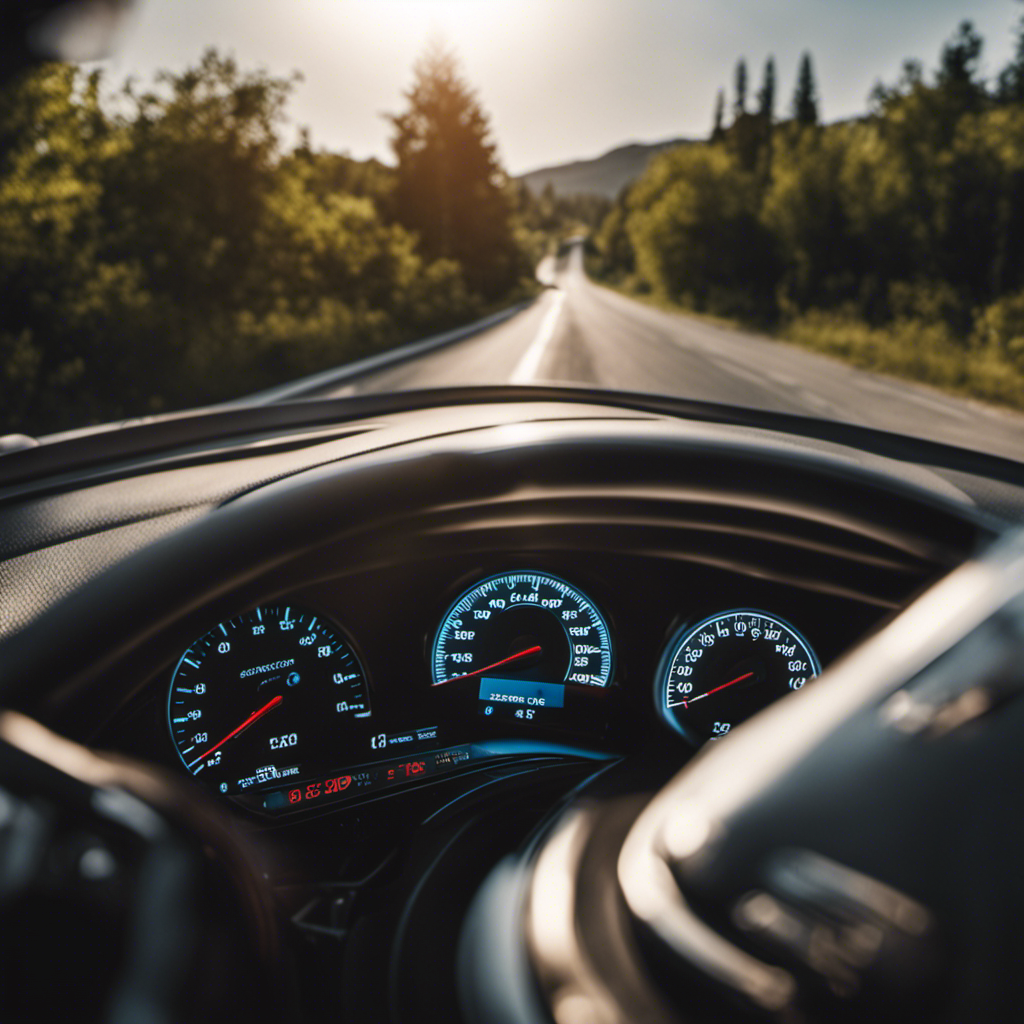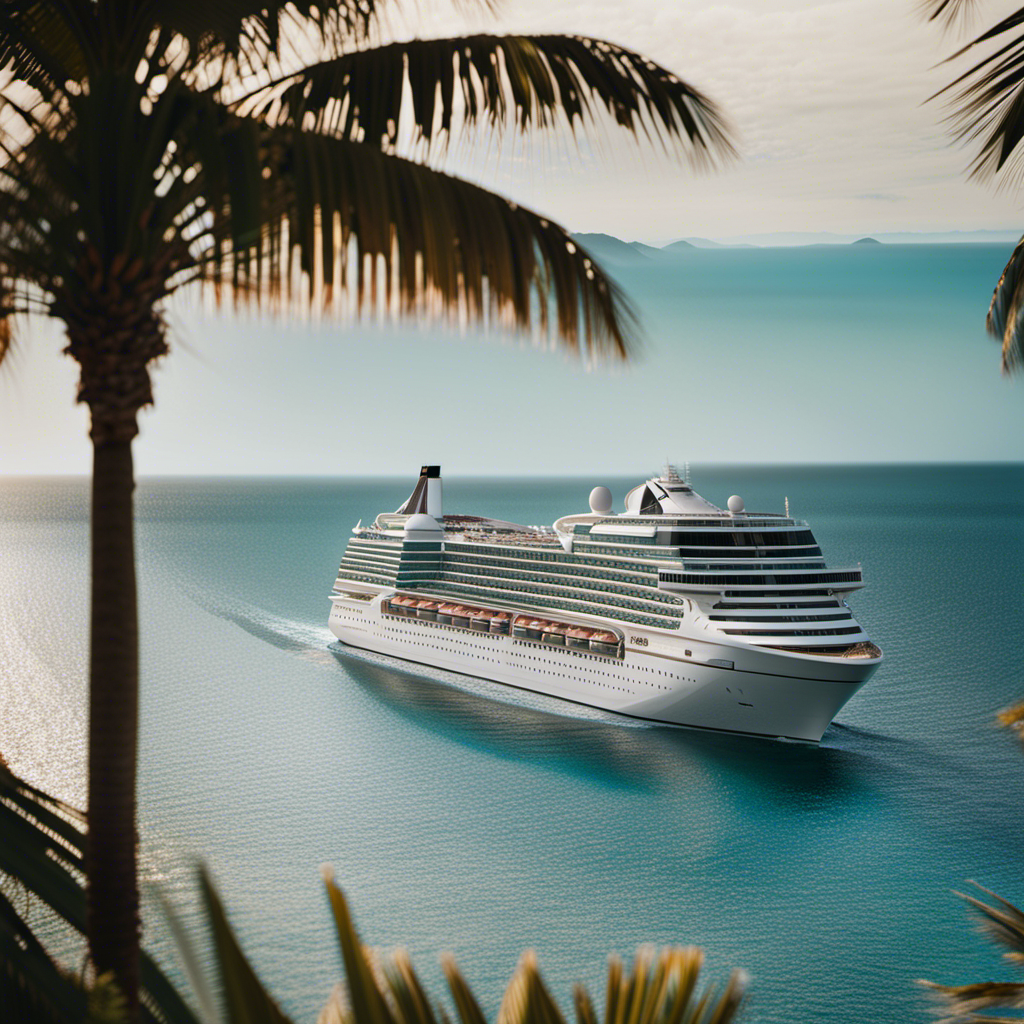Did you know that more than 90% of today’s cars are equipped with cruise control as a standard option? This widely preferred feature allows drivers to maintain a constant speed without having to keep their foot on the gas pedal constantly.
But have you ever wondered how this technology actually works? In this article, I will explain the inner workings of cruise control and break down its components, as well as provide useful tips for adjusting settings and troubleshooting common issues.
Let’s dive in and demystify how cruise control works.
Key Takeaways
- Cruise control reduces the need for constant acceleration and deceleration, improving fuel efficiency and reducing driver fatigue.
- Sensor technology plays a crucial role in the cruise control system, gathering real-time data on parameters such as vehicle speed.
- The control module receives input from sensors and makes adjustments to the throttle to maintain the desired speed.
- Cruise control utilizes a speed regulation mechanism to monitor the vehicle’s speed and adjust the throttle opening to control fuel delivery, either reducing or increasing throttle opening to slow down or accelerate the vehicle respectively.
History of Cruise Control
Cruise control was first invented and introduced in the 1940s by Ralph Teetor. Over the years, cruise control has evolved significantly, becoming a standard feature in many vehicles today.
Initially, cruise control systems were mechanical, relying on a throttle linkage to maintain a constant speed. However, with advancements in technology, electronic cruise control systems were developed. These systems use sensors to monitor vehicle speed and make adjustments accordingly.
The impact of cruise control on driving habits has been substantial. It allows drivers to maintain a consistent speed, reducing the need for constant acceleration and deceleration. This, in turn, improves fuel efficiency and reduces driver fatigue.
Transitioning into the subsequent section about the components of the cruise control system, let’s explore how these systems are designed and implemented.
Components of Cruise Control System
When it comes to the functionality of cruise control systems, sensor technology plays a crucial role in ensuring accurate and reliable performance.
The sensors used in cruise control systems are responsible for gathering real-time data on various parameters, such as vehicle speed, throttle position, and braking status.
This information is then processed by the control module, which uses it to make precise adjustments to maintain the desired speed set by the driver.
Sensor Technology in Cruise Control
The sensor technology in cruise control allows the vehicle to maintain a constant speed by continuously monitoring the speed of the vehicle and adjusting the throttle accordingly. These sensors, often located in the engine bay, detect the vehicle’s speed and send this information to the control module. The control module then determines the appropriate throttle position to maintain the desired speed set by the driver.
In recent years, sensor advancements have greatly improved the accuracy and responsiveness of cruise control systems. For example, radar-based sensors are being used to detect the distance between the vehicle and the one in front, allowing for adaptive cruise control systems that can automatically adjust the speed to maintain a safe following distance. The future of cruise control lies in further advancements in sensor technology, enabling more advanced features such as autonomous driving capabilities.
Transitioning to the subsequent section about the function of the control module, it plays a crucial role in processing the information received from the sensors and coordinating the various components of the cruise control system.
Function of Control Module
To understand how the control module functions, you need to know that it receives input from the sensors and uses that information to make adjustments to the throttle, maintaining your desired speed. The control module is the brain of the cruise control system, responsible for managing the cruise control programming. Here are the key functions of the control module:
-
Processing sensor data: The control module analyzes the input from various sensors, such as speed sensors and brake sensors, to determine the current vehicle speed and status.
-
Throttle adjustment: Based on the sensor data, the control module sends signals to the throttle actuator, instructing it to open or close the throttle valve, ensuring the desired speed is maintained.
-
Speed regulation: The control module continuously monitors the vehicle speed and adjusts the throttle position accordingly, compensating for any variations to keep the vehicle at the set speed.
-
System activation and deactivation: The control module controls the activation and deactivation of the cruise control system based on driver input, such as pressing the cruise control buttons or applying the brakes.
-
Diagnostic capabilities: The control module also performs self-diagnostics, monitoring the system for any faults or malfunctions and illuminating the cruise control warning light if necessary.
Now that we understand the control module’s functionality, let’s delve into how cruise control maintains speed without requiring constant driver intervention.
How Cruise Control Maintains Speed
When it comes to maintaining speed, the cruise control system utilizes a speed regulation mechanism. This mechanism is responsible for making throttle adjustments.
It works by monitoring the vehicle’s speed and comparing it to the set speed. If the vehicle exceeds the set speed, the mechanism will reduce the throttle opening. This limits the amount of fuel going into the engine and slows down the vehicle.
On the other hand, if the vehicle falls below the set speed, the mechanism will increase the throttle opening. This allows more fuel to enter the engine and accelerates the vehicle back to the desired speed.
Speed Regulation Mechanism
Cruise control adjusts the speed of the vehicle by controlling the amount of fuel being delivered to the engine. This is achieved through throttle control, which regulates the flow of fuel to the engine.
Here’s how the speed regulation mechanism works:
-
Set Speed: The driver sets the desired speed using the cruise control buttons. The system then maintains this speed until the driver intervenes.
-
Speed Sensors: Cruise control uses speed sensors to continuously monitor the vehicle’s speed. These sensors provide real-time feedback to the control module.
-
Fuel Delivery: Based on the speed feedback received from the sensors, the control module adjusts the throttle position to increase or decrease the amount of fuel being delivered to the engine. This allows the vehicle to maintain the desired speed without the need for constant accelerator pedal input.
With the speed regulation mechanism in place, cruise control ensures a consistent and comfortable driving experience.
Now, let’s explore how throttle adjustments contribute to maintaining speed.
Throttle Adjustments for Speed
You can maintain your desired speed by adjusting the throttle position, which controls the amount of fuel delivered to the engine. Throttle response plays a crucial role in engine performance, as it determines how quickly the engine will respond to changes in throttle input. By manipulating the throttle, you can fine-tune the engine’s power output and maintain a consistent speed.
To give you an idea of how throttle adjustments affect speed, take a look at the table below:
| Throttle Position (%) | Fuel Delivery (%) | Speed Adjustment |
|---|---|---|
| 0 | 0 | Decrease |
| 50 | 50 | Maintain |
| 100 | 100 | Increase |
As you can see, increasing the throttle position increases the fuel delivery and accelerates the vehicle, while decreasing the throttle position reduces the fuel delivery, slowing down the vehicle. This precise control over fuel delivery allows you to maintain your desired speed with ease.
Now, let’s move on to the next section, where we will discuss adjusting cruise control settings without interrupting the flow of your drive.
Adjusting Cruise Control Settings
To adjust your cruise control settings, simply press the ‘Set’ button and use the ‘+’ or ‘-‘ buttons to increase or decrease your desired speed.
Cruise control accuracy is a crucial aspect of this feature. Modern cruise control systems use advanced sensors to accurately maintain the set speed, adjusting as necessary to account for changes in road conditions or traffic.
Additionally, cruise control customization allows drivers to set their preferred speed limit, ensuring a comfortable and efficient driving experience.
By adjusting the cruise control settings, drivers can personalize their driving experience and maintain a consistent speed on long stretches of highway. This not only reduces driver fatigue but also improves fuel efficiency.
Using cruise control offers several benefits, such as reducing the risk of speeding and promoting a smoother ride.
Benefits of Using Cruise Control
Using cruise control can help drivers maintain a consistent speed and reduce the risk of speeding. It offers several benefits, including improved fuel efficiency and reduced driver fatigue.
Here are some advantages of using cruise control:
-
Fuel efficiency: Cruise control helps optimize fuel usage by maintaining a steady speed, eliminating unnecessary acceleration and deceleration.
-
Driver fatigue reduction: By relieving drivers from the constant need to monitor and adjust their speed, cruise control reduces mental and physical fatigue, allowing for a more relaxed driving experience.
-
Speed control: Cruise control ensures that the vehicle stays within the desired speed limit, helping drivers avoid unintentional speeding and potential traffic violations.
Common Issues With Cruise Control and Troubleshooting Tips
Now that we have discussed the benefits of using cruise control, let’s delve into the common issues that can arise with this system and some troubleshooting tips.
Cruise control malfunctions can occur due to various reasons such as faulty wiring, sensor issues, or mechanical failures. One common problem is the cruise control not engaging or disengaging properly. This could be due to a malfunctioning switch or a blown fuse.
Another issue could be the vehicle speeding up or slowing down unexpectedly while the cruise control is engaged, which might be caused by a faulty speed sensor or throttle position sensor.
Troubleshooting these problems involves checking the fuse, inspecting the wiring connections, and testing the various sensors involved in the cruise control system. It is also important to consult the vehicle’s manual for specific troubleshooting steps and to seek professional assistance if needed.
Frequently Asked Questions
Can Cruise Control Be Used in All Types of Vehicles?
Yes, cruise control can be used in most types of vehicles. It offers several advantages, such as maintaining a constant speed and reducing driver fatigue. However, it is important to consult the vehicle’s manual for compatibility and specific instructions.
Is It Safe to Use Cruise Control in Inclement Weather Conditions?
When it comes to using cruise control in inclement weather conditions, there are safety considerations to keep in mind. While it offers benefits like maintaining a consistent speed, it can also have drawbacks like reduced control and responsiveness.
Can Cruise Control Help Reduce Fuel Consumption?
Yes, cruise control can help reduce fuel consumption. When activated, it maintains a steady speed, allowing for more efficient driving. However, it’s important to note that driving behavior and habits also impact fuel consumption.
How Does Cruise Control Handle Steep Inclines or Declines?
When handling steep inclines or declines, cruise control adjusts the vehicle’s speed to maintain a consistent pace. It automatically increases throttle on inclines and applies brakes or downshifts on declines, ensuring a smooth and controlled ride.
Can Cruise Control Be Used in Conjunction With Other Driver-Assistance Systems Like Adaptive Cruise Control or Lane-Keeping Assist?
Yes, cruise control can be used in conjunction with other driver-assistance systems like adaptive cruise control or lane-keeping assist. These systems work together to provide enhanced safety and convenience, such as collision avoidance and pedestrian detection.
Conclusion
In conclusion, cruise control is like having a loyal co-pilot on your journey, taking care of the speed while you focus on the road ahead. With its intricate system of components and precise mechanisms, it ensures a smooth and effortless ride.
By allowing you to adjust the settings and maintain a consistent speed, it takes the stress out of long drives. However, like any technology, it can sometimes face hiccups, but armed with troubleshooting tips, you can navigate through them like a seasoned captain.
So sit back, relax, and let cruise control be your trusty companion on the open road.










